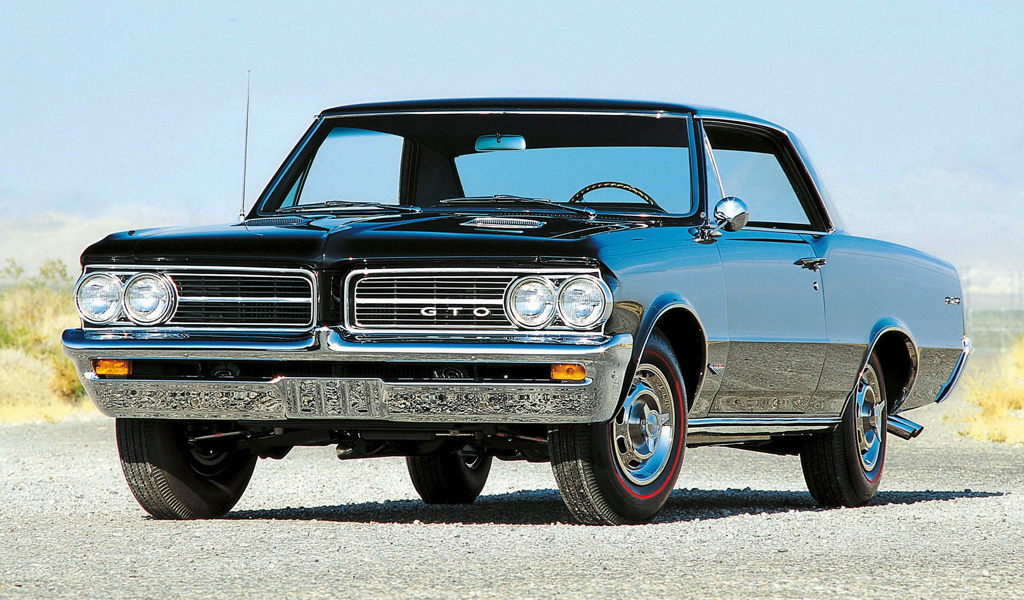
In the first half of the 1950s, Pontiac’s product line could be politely described as “sedate”. The division’s cars were well-built and reliable, but they were intended for a mature customer who wanted transportation in a reserved package. Nothing fancy. Respectable. Boring, even. Then in 1956, new leadership came to General Motors.
Sales at Pontiac had been slipping, and 1955 was a particularly off year and a real wake up call for Pontiac. Considering killing the division, top management decided to first try to reinvigorate it with new blood. Perhaps by design and perhaps by luck, the stars aligned and a new “dream team” was created. And it all started with Semon E. “Bunkie” Knudsen.
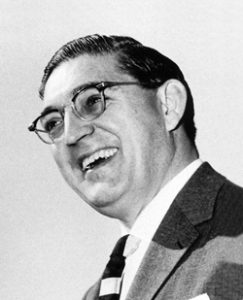
Bunkie was the son of “Big Bill” Knudsen who had been the top man at Chevrolet for 13 years before becoming President of General Motors. Bunkie was an engineer and a car guy through and through. He had risen through the ranks at Pontiac to become in 1956 the General Manger of the Pontiac Division – at 43 years old the youngest GM at GM. One of the first things he did was bring performance-minded people to Pontiac.
E.M. “Pete” Estes was an Oldsmobile man, and another dyed-in-the-wool car guy. He held the positon of Assistant Chief Engineer at Olds, and had made great progress in multiple carburetion on passenger cars. At the time Bunkie called, he was working on adding three two-barrel carburetors to the Olds Rocket V-8 engine and was close to bringing the design into production. Bunkie convinced upper GM management to let him hire Estes away from Oldsmobile and make him Chief Engineer at Pontiac. One of the first things Estes did was hire a young Assistant Engineer away from Studebaker-Packard named John DeLorean.
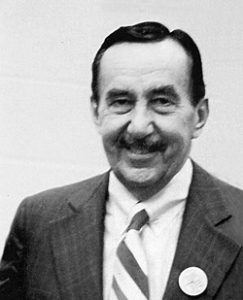
E.M. “Pete” Estes
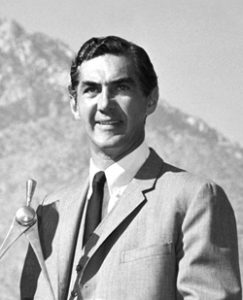
John Z. DeLorean
Knudsen and Estes became friends and were kindred spirits pursuing performance. Russ Gee, an engineer assigned to road test engines, related the story of Knudsen and Estes showing up at GM’s proving grounds on a Saturday to personally drive the Pontiac prototypes for 1957. They wanted to try the new 347ci V-8 that was in validation testing. After having fun racing each other around the track for a few hours, they decided then and there that Pontiac was going stock car racing. And they made Russ Gee the head of the racing program!
Bunkie and Pete knew they had a winner in their cars, and they wanted the world to know it, too. There were many teething problems while Gee and the other Pontiac engineers developed their engines and chassis for high speed racing. They were successful in increasing power and reliability to the point that Pontiac entered its first NASCAR race in 1957 and won!
Another development in 1957 was not so welcome. A majority of members of the Automobile Manufacturers Association (AMA) voted to suspend all competition in racing activities by manufacturers because of safety concerns. This was not a binding agreement, but most manufacturers withdrew from racing and in fact this became corporate policy at General Motors. Knudsen continued Pontiac’s racing activities in secret, however, and Pontiac reigned supreme at the NASCAR tracks from 1957 until 1962. An important part of that racing success was a new “Tri-Power” triple carburetor engine courtesy of Pete Estes. But it was in no small part due to the activities of a young marketing executive named Jim Wangers!
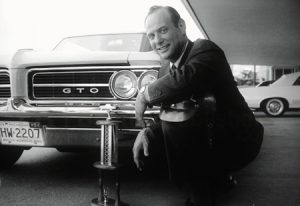
Jim Wangers
Jim worked for the marketing firm handling the Pontiac account and also was a staunch car guy. Wangers reasoned that the corporation had banned the division from racing, but it couldn’t ban its customers from racing! He got approval from Knudsen to create a traveling “performance seminar” to teach Pontiac dealers nationwide how to promote and sell performance parts. The dealers were not subject to the corporate racing ban. One of those dealers, Royal Pontiac in Royal Oak Michigan, built a series of cars for racing, and Wangers successfully campaigned one of them in drag racing. The net result was that the racing continued, and the cars got better and better.
Score? Gear heads one, corporate ban zero!
Going against corporate policy could have been disastrous for the new management team at Pontiac, except for one thing. Pontiacs started selling like hot cakes! Wangers had started promoting Pontiac performance to the market, and the market spoke. A new customer had appeared in America; one that was young, excited by high performance automobiles, and that had the cash to buy them. Class victories at Daytona Beach and unrelenting victories in NASCAR supplied the foundation for advertising campaigns aimed at this customer, and by 1962 Pontiac was the third best-selling car brand in America, just behind Ford and Chevrolet! All this was done by appealing to the public’s desire to own a performance automobile – or at least one of the same brand.
Ironically, this success broke up the dream team. Bunkie Knudsen was made the General Manager of Chevrolet and so left Pontiac. However, Pete Estes took over as General Manager of Pontiac, and John DeLorean became its Chief Engineer.
John DeLorean was a dynamic man who thought outside the box. For example, he was instrumental in designing the innovative Tempest; the car with the “half a V-8” four cylinder engine, a flexible “rope” driveshaft, and a transmission and differential combined into a transaxle at the rear of the car. It won a number of engineering awards, but it was costly to produce and had above-average warranty claims. The worst aspect was it was a slow seller, with only a third of the sales of Chevrolet’s Corvair. In an effort to bring performance even to the Tempest, in 1963 the Royal Pontiac dealership developed a high performance version of the Tempest called the “Bobcat”. Even though it was not successful because its engine overpowered its drivetrain, it was a first try at putting a performance engine into a regular production compact Pontiac. Delorean loved it, and learned from the experience. DeLorean had noticed many other things, too.
A change in the cultural aspect of racing was beginning to form in America. Drag racing was an established sport, but it did not yet have the wide popularity of NASCAR. That was rapidly changing. As dragsters approached and passed the 200mph barrier, drag strip crowds rapidly grew all across the country. This passion lead to emulation – kids with cars began to hold drag races of their own on public streets, and to build ever more competitive cars themselves. That presented a golden sales opportunity, but once again the corporate ban on performance and racing presented obstacles.
Early in 1963, GM chairman Frederic Donner decreed that all car divisions immediately cease racing activities and conform to the 1957 AMA ban. There were no exceptions to be made – he was serious! Perhaps the main underlying reason for this decree was that General Motors had grown so big and controlled such a big piece of the market that there was real concern the US government was going to declare it a monopoly and break it up. This was also the time when the government was getting into safety and emissions regulations, and GM wanted to remain in good standing with the politicians. So the order went out – stop all racing activities. There went Jim Wangers’ marketing campaign, but Wangers did not lie down.
Wangers had an answer, and it gave birth to the muscle car era. He wrote John DeLorean a memo which said “As ugly as it sounds, we need to take racing off the track and put it on the street.” De Lorean concurred. There was now real demand for high performance cars, and Pontiac could sell a lot of cars to that market. However, the Bobcat Tempest experiment was a failure, and what other car could they use?
Fortunately, Pontiac had a brand new Tempest available – one that was body-on-frame, had a front engine with the transmission mounted to it, and had a conventional driveline. In one informal Saturday morning engineering meeting while inspecting a preproduction car, one of DeLorean’s assistant Chief engineers, Bill Collins, noticed that the 389ci V-8 engine would slip right into place instead of the economy engine. It was a eureka moment. A week later, the conversion was done and the car was up and running. It was an instant hit! DeLorean used the prototype to commute and could even be seen occasionally racing it on Woodward Avenue late at night.
Now, how to get around the corporate ban? How could they get permission to build the car?
The answer was not to ask permission. Pete Estes realized that while new models needed corporate approval, new option packages did not! When asked if they should build the car under the guise of it being an option of an economy car, it is not hard to imagine John Delorean, Jim Wangers, Russ Gee, Bill Collins, and all the rest of the gear heads at Pontiac shouting YES!!! And so DeLorean was given the green light to put the car into production.
The score now? Gear heads TWO, corporate ban zero!
Everyone knew the project had to be kept secret or heads would roll. The team managed somehow, even during testing at the proving grounds. It was during this time that the option package specifications were developed and the car received its identity. The package hit many hot buttons of the time. Pontiac had been using racing names for its products – Bonneville, LeMans, Grand Prix – and so DeLorean thought the car should be called GTO to continue the racing theme and to invoke associations with the Ferrari GTO and European prestige. The engine was badged “6.5 Litre” for this reason, but the manual shifter was the all-American Hurst shifter, standard. They decided to offer the GTO as an option package on the LeMans.
And what options they were! A buyer could customize the GTO package with almost unlimited options including a limited slip differential, tachometer, heavy duty suspension, and the iconic three two-barrel carburetors and four speed transmission. This was the three deuces and a four speed immortalized in the chart topping song “Little GTO”.
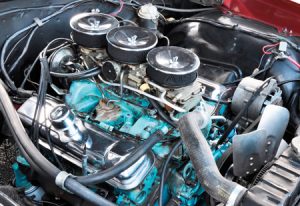
This is a contemporary photo of a very correct, low mileage engine.
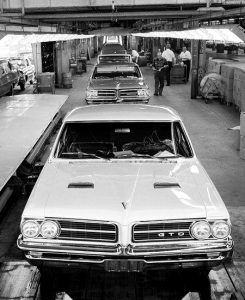
GTOs coming down the line!
It had all come together. Pontiac was the first car company to market a high performance car as a category unto itself, and to establish it as a lifestyle choice. The car was beautiful, affordable, and fast. It said a great deal about its buyers, and its buyers loved what it had to say. Initially projected to sell 5,000 copies, the GTO blew past estimates and sold more than 32,000 units its first year. It was the most exciting car introduction of its time, and the Muscle Car Era was born!
Epilogue
Pete Estes was called on the carpet for going around the corporate edict, but because the car was a sales smash hit, he was actually promoted to head of Chevrolet replacing Bunkie Knudsen.
Following up on the lifestyle image of the GTO, various GTO products were introduced and sold including shoes, cologne, shaving products, and popular records. It also entered the entertainment industry. A highly customized GTO was used on “The Monkees” TV series. On “I Dream Of Jeannie”, astronaut Anthony Nelson drove a GTO.
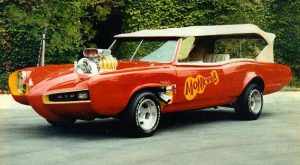
The Monkeemobile!
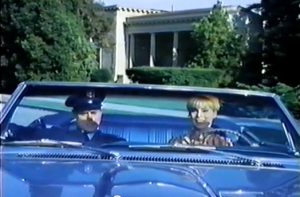
I Dream Of Jeannie GTO. Every guy’s fantasy!
The car was also known as “The Goat”, “The Tiger”, “GeeTO”, “The Humbler”, and more depending where you lived.
It was a sales success, increasing from the first year annual sales volume of 32,450 to 75,342 in 1965 to a best year’s sales of 96,946 in 1966. It remained a top seller throughout the muscle car era.
John DeLorean became the head of the Pontiac division – at 40 years old the youngest division head ever at GM. He developed and brought the Pontiac Firebird into production during that time. He was later promoted to Pete Estes’ old job, the head of the Chevrolet division. While there, he grew Chevrolet to be almost as big as the entire Ford Motor Company. However, he resigned his position most likely as a result of the political situation at GM at that time. He later founded the DeLorean Motor Company, and once again developed and produced innovative automobiles.
-William Hoffer, Director of Marketing, Grundy Insurance







